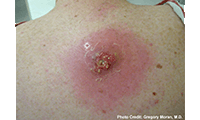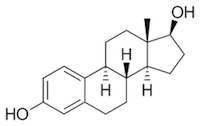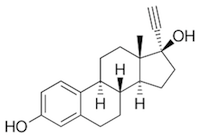This is a glossary of many terms that I commonly use in this website. This page is automatically generated from a YAML file using the Liquid templating language. Each item in the source file may contain 1) a term, 2) a definition, 3) a MathJax equation, and 4) an image. I have written a blog post describing this resource further.
16S rRNA
- A 1,500 base pair RNA molecule that is found in the small subunit of the prokaryotic ribosome. This component recognizes the Shine-Dalgarno sequence and places the ribosome in register during intiation of translation. The sequence of this molecule is the genetic basis for much of the molecular taxonomy done today. Eukaryotic ribosomes contain 18S rRNA.
abiogenesis
- The theory that some organisms originated from inorganic materials.
abscess
-
 An area of the body marked by the accumulation of pus. This can result in redness, pain, and swelling, and is often associated with bacterial infections.
An area of the body marked by the accumulation of pus. This can result in redness, pain, and swelling, and is often associated with bacterial infections.
acid-fast
- Stained bacteria that are not easily destained by acidic washes - this mainly refers to members of the genus Mycobacterium.
acidophile
- An organism that grows optimally under acidic conditions
acquired immunity
- The adaptive immune system that provides specific defenses against antigens and has an immunological memory. This system consists of interactions between antigen presenting cells, B cells, and T cells. The humoral and cell-mediated defenses are both part of acquired immunity.
activation energy
- The amount of energy that must be added to a reaction in order for the substrates to form their corresponding products.
active immunity
- Immune protection afforded to an individual by being exposed (either naturally or artificially) to a foreign antigen. This protection is specific and lasting.
active site
- A region of an enzyme's three-dimensional shape where substrates bind and catalysis takes place.
active transport
- Carrier-mediated, energy-dependent translocation of a substrate across a membrane without chemical modification.
acute infection
- A disease marked by the rapid onset of symptoms with severe intensity, often of relatively short duration.
acyclovir
-
 This antiviral drug is a synthetic purine nucleoside with selective activity against herpes simplex virus and a few other viruses. It is used in the treatment of cold sores and genital herpes infections. It is a substrate for the viral polymerase and messes up viral replication.
This antiviral drug is a synthetic purine nucleoside with selective activity against herpes simplex virus and a few other viruses. It is used in the treatment of cold sores and genital herpes infections. It is a substrate for the viral polymerase and messes up viral replication.
adherence
- The process of sticking to an animate or inanimate surface - the first critical step in colonization or infection by a microbe.
adsorption
- The adhesion and accumulation of a material to the surface of another.
aerobe
- An organism that requires the presence of oxygen for survival.
aerobic respiration
- A metabolic process in which the oxidation of substrates is linked to the reduction of oxygen to form water.
aerosol
- A suspension of tiny liquid or solid particles in the atmosphere.
agammaglobulinemia
- A congenital disease that results in the lack of immunoglobulin production.
agglutination
- The process of clumping organisms or particles together into larger complexes.
AIDS
- Aquired immunodeficiency syndrome (AIDS) is the clinical manifestation of HIV infection. Individuals with AIDS are unable to mount a normal immune response and become susceptible to otherwise trivial microbial infections.
algae
- A group of non-vascular aquatic plants - some are microbes, while other may be quite large.
alkalinophile
- An organism that grows optimally under alkaline conditions.
allergen
- A substance that provokes an allergic response in an individual.
allergy
- Also known as a hypersensitivity. An exaggerated or inappropriate immune response initiated by exposures to antigens such as mold spores, pollen, or certain drugs and foods.
allotype
- Antibody variants whose peptide sequences differ due to allelic variations between individuals.
amantadine
- Amantadine is a synthetic (man-made) anti-viral drug that can inhibit the replication of influenza viruses in cells.
ameboid movement
- A type of microbial locomotion involving cytoplasmic extensions, in the form of pseudopodia, due to cytoplasmic streaming.
Ames, Bruce
- Bruce Ames (1928 - ) is the microbiologist who devised the Ames test in the 1970s.
Ames test
- A biochemical test to measure the mutagenic potential of chemical compounds using a histidine-requiring bacterial strain - the mutation rate is measured by the incidence of colonies able to grow in the absence of added histidine.
aminoglycoside
- A class of antibiotics that inhibit translation by binding to the ribosome 30S subunit.
amphipathic
- The property of some molecules that have regions that are able to hydrogen bond to water (hydrophilic) and other regions that are not (hydrophobic).
amphitrichous
- Bacterial cells with one or more flagella at each pole.
amphotericin B
- This is a polyene anti-fungal drug. It was originally isolated from Streptomyces nodosus, and is often used intravenously in systemic fungal infections.
anabolism
- Endergonic chemical reactions in an organism that build more complex molecules from simpler building blocks.
anaerobe
- An organism that does not require oxygen for growth - many anaerobes are actually inhibited or killed by the presence of oxygen.
anaerobic respiration
- A metabolic process in which the oxidation of substrates is linked to the reduction of an inorganic ion.
analog
- A substance with a molecular structure similar to a molecule of interest.
anaphase
- The phase of mitosis or meiosis in which the separation of chromatids takes place to opposite poles of the cell.
anaphylaxis
- A severe allergic reaction that may result in shock and even death.
anergy
- Lack of response of the immune system to a particular antigen.
anneal
- The process in which two single strands of DNA or RNA bind by hydrogen bonding to form one double-stranded molecule.
anoxic
- An environment with very little or no dissolved oxygen available.
anoxygenic photosynthesis
- Bacterial photosynthesis using electron donors other that water - oxygen is not produced as a by-product.
antibiotic
- Antimicrobial compounds that are produced by other organisms.
antibody
- See immunoglobulin
anticodon
- A three nucleotide sequence on a tRNA complementary to a codon on an mRNA.
antigen
- A substance containing one or more structural domains that can react specifically with antibodies.
antigen presentation
- The process wherein a phagocyte displays an antigenic peptide fragment of foreign origin on its surface in conjunction with a major histocompatibility protein. This complex can be recognized by T cells and results in the stimulation of the immune system through the production of cytokines.
antigenic determinant
- A portion of an antigen that is specifically bound by an antibody - also referred to as an epitope.
antigenic drift
- Minor genetic variations in the influenza virus spike proteins because of the slow accumulation of spontaneous mutations.
antigenic shift
- Major variations in the influenza virus spike proteins as a consequence of reassortment of the RNA genetic fragments during coinfections of cells with more than one variant of the influenza virus.
antisepsis
- The reduction in the number of viable vegetative microbes on a living surface.
antitoxin
- Serum that contains antibodies capable of binding and neutralizing specific toxins of microbial or other origin.
apicomplexans
- A group of non-motile protozoa that are obligate pathogens - they contain a complex of microtubules at one pole of the cell. This group includes the malaria parasite.
apoptosis
- A process of programmed cell death responsible for the elimination of old or damaged host cells.
Appert, Nicolas
- Nicolas Appert (1750 - 1841) was a French pioneer of food preservation by canning. He devised a method of sealing food in glass jars and sterilized them with boiling. This won him a prize from the French government (which was busy trying to find ways to feed Napoleon's troopts). Appert is also the inventer of the boullion cube.
archaea
- Prokaryotic microorganisms that differ from the true Bacteria genetically and biochemically. Most notably, they lack true peptidoglycan, have discernibly different ribosomal structure, and contain ether-linked lipids in their membranes.
arthrospore
- An asexual spore formed from a thickened segment of a septate hypha in some fungal species.
ascomycetes
- A group of fungi characterized by the production ofsexual spores within an oval or tubular membranous sac called an ascus. This group includes brewer's yeast and the mold that makes penicillin.
ascospore
- A sexual spore contained within a sac in fungi of the class Ascomycetes.
ascus
- A sac-like structure containing the sexual ascospores in members of the Ascomycetes.
aseptic technique
- Procedures used to prevent contamination of microbial samples, the laboratory, and the lab personnel.
asymptomatic
- A chronically or actutely infected individual who has not manifested any sign of disease.
ATP
- adenosine triphosphate - this nucleotide is the main storage form of chemical energy in the cell.
ATPase
- A multi-protein membrane structure that uses energy in the form of a proton gradient to generate ATP from phosphate and ADP. This is the major source of ATP during photosythesis and respiration.
attenuated
- A weakened, less virulent strain of a microbial pathogen. Such strains are sometimes used as laboratory strains or for the production of vaccines.
attenuation
- A form of genetic control exerted by alternate RNA secondary structure and the production of a short leader peptide. Under starvation conditions, the leader product is not formed and the regulated genes are expressed.
autoclave
- A machine used to sterilize materials using pressurized steam - typically, these devices operate at 15 psi and 121 degrees C.
autoimmune disease
- A situation where the host's own immune system recognizes self-antigens as foreign. The resulting immune response directly damages host tissue and results in loss of function.
autolysis
- Programmed cell death resulting in the self-destruction of damaged, diseased, or obsolete cells.
autotroph
- An organism that uses carbon dioxide as its sole carbon source.
auxotroph
- A mutant organism that has additional nutrient requirements compared to the wild type strain.
Avery, Oswald
- Oswald Avery (1877 - 1955) extended the work of Griffith and showed that DNA is the transforming material in streptococci - he also made important contributions to the classification of pneumococci.
azidothymidine
- Azidothymidine (AZT) is a thymine analog that is misincorporated by the HIV reverse transcriptase. This causes chain termination and blocks viral replication.
endocrine disruption
- foo
estradiol
-
 Estradiol is a form of the hormone estrogen. It’s also called 17β-estradiol or E2. The ovaries, breasts, adrenal glands, and the placenta during pregnancy are all capable of producing E2. Estradiol is important for the growth and development of female sex organs, including the uterus, fallopian tubes, vagina, and breasts. Estradiol also helps to control the way fat is distributed in the female body and is essential for bone and joint health in females.
Estradiol is a form of the hormone estrogen. It’s also called 17β-estradiol or E2. The ovaries, breasts, adrenal glands, and the placenta during pregnancy are all capable of producing E2. Estradiol is important for the growth and development of female sex organs, including the uterus, fallopian tubes, vagina, and breasts. Estradiol also helps to control the way fat is distributed in the female body and is essential for bone and joint health in females.
ethinylestradiol
-
 Ethinylestradiol (EE2) is is a synthetic derivative of estradiol that acts as an agonist of the estrogen receptor. It differs from estradiol in several important ways. 1) EE2 has greater bioavailability when taken by mouth, 2) it is more resistant to microbial metabolism, and 3) it elicits increased biological effects in the liver and uterus. These differences make EE2 a favored choice for use in birth control pills. However, EE2 has also been associated with an increased risk of blood clots and other adverse effects.
Ethinylestradiol (EE2) is is a synthetic derivative of estradiol that acts as an agonist of the estrogen receptor. It differs from estradiol in several important ways. 1) EE2 has greater bioavailability when taken by mouth, 2) it is more resistant to microbial metabolism, and 3) it elicits increased biological effects in the liver and uterus. These differences make EE2 a favored choice for use in birth control pills. However, EE2 has also been associated with an increased risk of blood clots and other adverse effects.
mean
-
 The mean is the average of all numbers and is sometimes called the arithmetic mean. To calculate mean, add together all of the numbers in a set and then divide the sum by the total count of numbers. In a normal distribution, the mean is found at the exact center of the curve and is coincident with the peak. The mean, median, and mode of a standard curve are all identical.
The mean is the average of all numbers and is sometimes called the arithmetic mean. To calculate mean, add together all of the numbers in a set and then divide the sum by the total count of numbers. In a normal distribution, the mean is found at the exact center of the curve and is coincident with the peak. The mean, median, and mode of a standard curve are all identical.
$$\mu = \frac{\bigg(\displaystyle\sum\limits_{i=1}^{N} X_i\bigg)}{N}$$ meta-analysis
- foo
reliability
- Reliability in statistics and psychometrics is the overall consistency of a measure. A measure is said to have a high reliability if it produces similar results under consistent conditions. It is the characteristic of a set of test scores that relates to the amount of random error from the measurement process that might be embedded in the scores. Scores that are highly reliable are accurate, reproducible, and consistent from one testing occasion to another. That is, if the testing process were repeated with a group of test takers, essentially the same results would be obtained.
reproducibility
- foo
significance
- foo
steroid
- A short definition
tidyverse
- foo
validity
- foo

